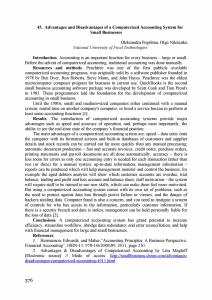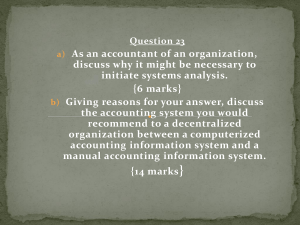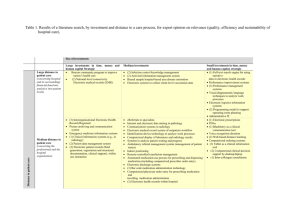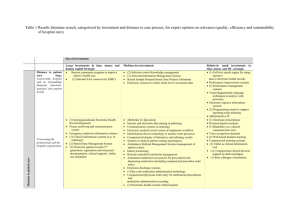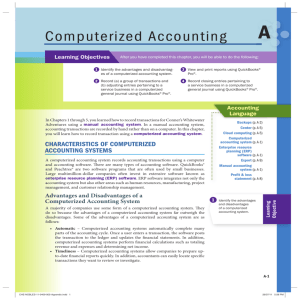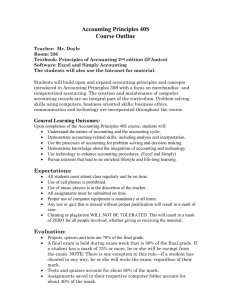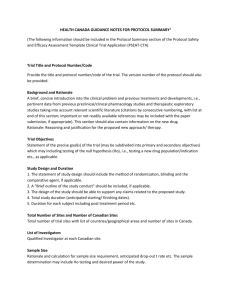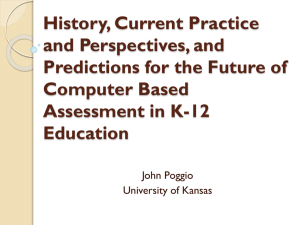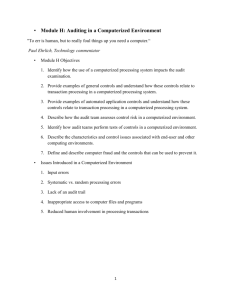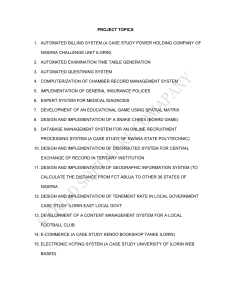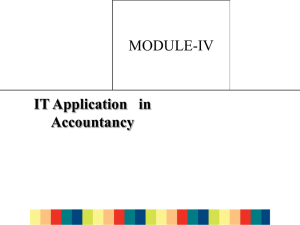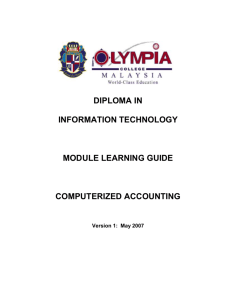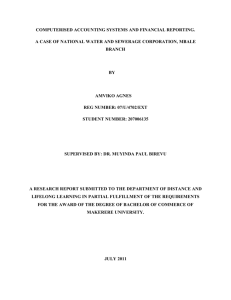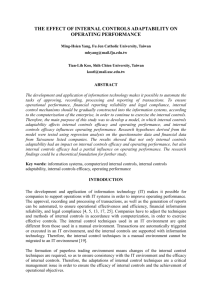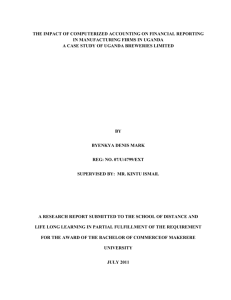12 Steps to Understanding a Quantitative Research Report
advertisement
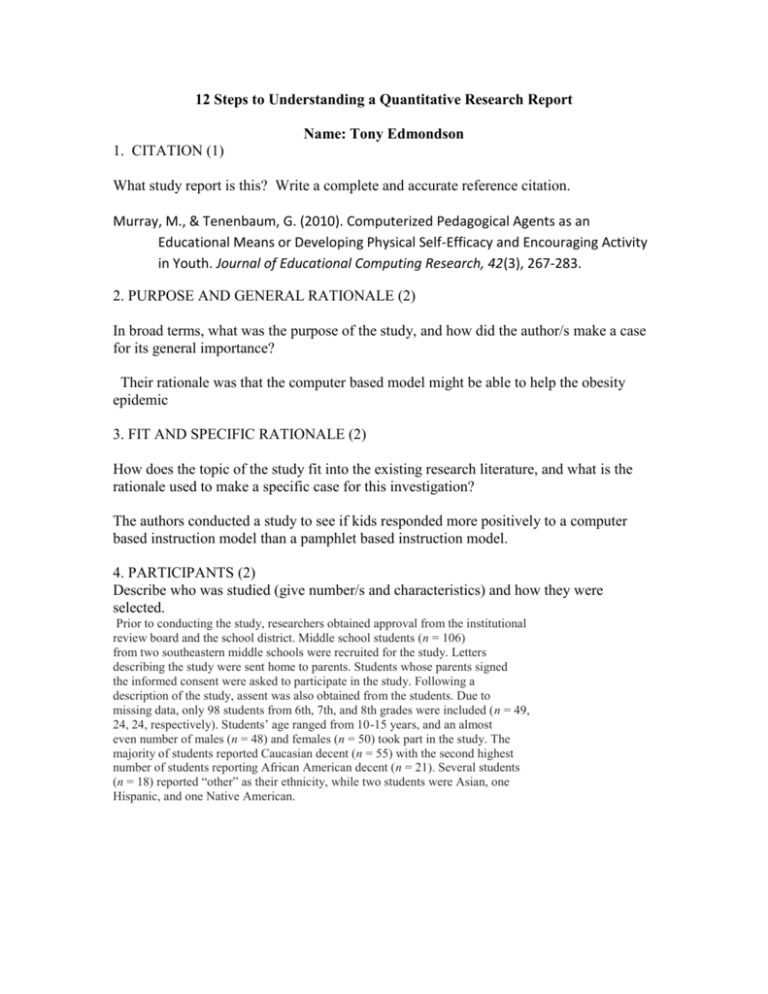
12 Steps to Understanding a Quantitative Research Report Name: Tony Edmondson 1. CITATION (1) What study report is this? Write a complete and accurate reference citation. Murray, M., & Tenenbaum, G. (2010). Computerized Pedagogical Agents as an Educational Means or Developing Physical Self-Efficacy and Encouraging Activity in Youth. Journal of Educational Computing Research, 42(3), 267-283. 2. PURPOSE AND GENERAL RATIONALE (2) In broad terms, what was the purpose of the study, and how did the author/s make a case for its general importance? Their rationale was that the computer based model might be able to help the obesity epidemic 3. FIT AND SPECIFIC RATIONALE (2) How does the topic of the study fit into the existing research literature, and what is the rationale used to make a specific case for this investigation? The authors conducted a study to see if kids responded more positively to a computer based instruction model than a pamphlet based instruction model. 4. PARTICIPANTS (2) Describe who was studied (give number/s and characteristics) and how they were selected. Prior to conducting the study, researchers obtained approval from the institutional review board and the school district. Middle school students (n = 106) from two southeastern middle schools were recruited for the study. Letters describing the study were sent home to parents. Students whose parents signed the informed consent were asked to participate in the study. Following a description of the study, assent was also obtained from the students. Due to missing data, only 98 students from 6th, 7th, and 8th grades were included (n = 49, 24, 24, respectively). Students’ age ranged from 10-15 years, and an almost even number of males (n = 48) and females (n = 50) took part in the study. The majority of students reported Caucasian decent (n = 55) with the second highest number of students reporting African American decent (n = 21). Several students (n = 18) reported “other” as their ethnicity, while two students were Asian, one Hispanic, and one Native American. 5. CONTEXT (2) Where did the study take place? Describe any important characteristics of that context. The article only mentions the Southeast…I am assuming of the United States. 6. STEPS IN SEQUENCE (3) In the order performed, what were the main procedural steps in the study? Describe or diagram in a flow chart, showing order and any important relationships among the steps. 1. Students provided demographic information by answering a series of questions prior to beginning the program. 2. Students in the two experimental groups were randomly assigned to one of two treatment groups, while the students in the control group (n = 29) were selected by class. 3. A quasi-experimental design was employed 4. Students in the control classes were exposed to written education materials 5. Students receiving the computerized intervention interacted with the agent(s) in a series of five 40-minute sessions over 5 consecutive weeks. 7. DATA (3) What constituted data (e.g., test scores, questionnaire responses, frequency counts), how was it collected, and what was the role of the investigator/s in that process? A 15-item, hierarchical-type questionnaire to assess student efficacy for engaging in physical activity outside of school was developed for the proposed study. The students indicate how confident they are in their ability to engage in exercise outside of school on a 5-point Likert-type scale, ranging from 1 (not at all confident) to 5 (very confident). Transtheoretical Model Stage of Change for Exercise Behavior (SEBC; Wyse, Mercer, Ashford, Buxton, & Gleeson, 1995) The Attitude Toward Tutor Agent Scale (ATTAS; Adcock & Van Eck, 2005) was modified for the present research. (Likert) Ten multiple-choice questions were designed for the study to measure health and fitness knowledge. 8. ANALYSIS (3) What form of data analysis was used, and what specific questions was it designed to answer? What (if any) statistical operations and computer programs were employed? Baseline measures of all dependent variables were compared among the two experimental groups and the control group. Non-significant group differences were obtained for self-efficacy, F(2, 95) = 1.31, p = .274, stage of change, F(2, 95) = .375, p = .688, physical self-perceptions, F(2, 95) = 1.09, p = .341, and perceptions of importance of physical activity, F(2, 95) = .301, p = .741. This preliminary analysis voids the need to control for baseline levels in the repeated measures design. 9. RESULTS (3) What did the author/s identify as the primary results (products or findings produced by the analysis of the data)? Students interacting with the instructor and peer agent not only have the agents as models, a form of vicarious experience, but were also exposed to social persuasion techniques. The findings in the current study indicate a gradual increase in exercise efficacy over time for all conditions. However, students exposed to a computerized peer agent demonstrated significantly greater levels of exercise efficacy in testing periods 3–6 than students in the instructor or control condition. 10. CONCLUSIONS (3) What did the author/s assert about how the results in Step 9 responded to the purpose/s established in Step 2, and how did the events and experiences of the entire study contribute to that conclusion? Results from this preliminary study, however, support further examination of the use of computerized agents. Furthermore, most of the students in the present study reported baseline stage of change as rather high, creating a ceiling effect for change in this sample. Correspondingly, high participation rates in sport and physical activity were present at baseline. 11. CAUTIONS (2) What cautions does the author/s raise about the study itself or about interpreting the results? Add here any of your own reservations. A small sample size of students in each condition limited the power of the statistical analyses, making it difficult to obtain significant differences across groups. Power was calculated for the present study to be .6, which is slightly less than the .8 suggested for behavioral science research (Green, 1991). 12. DISCUSSION (3) What interesting facts or ideas did you learn from reading the report? Include here anything that was of value, including: results, research designs and methods, references, instruments, history, useful arguments, or personal inspiration. I like to include technology in the gym. I included anything that I can plug in as technology, so I am stretching it. I have been looking for programs that I can use to help motivate the kids. To find research that promotes the use of technology to motivate the kids is really interesting. Submit a copy of the study’s abstract as an attached .pdf file (1) ABSTRACT Physical activity participation rates in the United States have been in steady decline for the last 25 years, so much so that 60% of youth ages 9-13 years get no physical activity outside of school. This state of inactivity indicates that promoting participation in physical activity at a young age is of importance. For the present study, a computerized intervention based on the Transtheoretical Model and Social Cognitive Theory was designed and implemented in a school setting to study its potential effectiveness on self-efficacy and stage of change for physical activity. Participants (n = 98) were divided into three conditions. Students in the two experimental conditions interacted with a computerized agent program for 40 minutes, once per week for 5 weeks. Students in the control group received the same educational information in written form. Results support the use of computerized human agents for increasing exercise efficacy and health and fitness knowledge. Total points = 30 Passing criterion = 27
